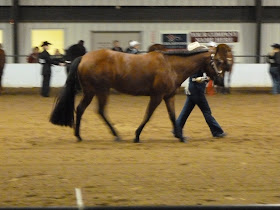AQHA showmanship rules state:
-Judged strictly on the exhibitor’s ability to fit and show a horse at halter
-The horse is merely a prop to demonstrate the ability and preparation of the exhibitor
-The ideal showmanship performance consist of a poised, confident, neatly attired exhibitor leading a well-groomed and conditioned horse that quickly and efficiently performs the requested pattern with promptness, smoothness and precision
-Showmanship is not a halter class on the horses confirmation and should not be judged as such
When judged, half of the points go to performance, and the other half go to the appearance of the handler and horse (as in condition of the horse, not conformation). So it is more important that your horse and handle have a good turn out (looks) than your horse's actual build. For rules on appearance, you can go here!
With that in mind, here are some pictures from the showmanship classes. Again, I apologize for my camera's lack of cooperation.
The pattern looked like this:
First, the horse and handle halt at Cone A and wait for the judge to nod, signaling he is ready for you to begin. The horse should be standing square, patient, and alert, while the handler is paying attention to the judge and waiting for the nod.
Once the judge nods, the pattern should be started. For this specific pattern, you should walk from Cone A to Cone B.
"The exhibitor should perform the work accurately, precisely, smoothly, and with a reasonable amount of speed. Increasing speed of the work increases the degree of difficulty, however, accuracy and precision should nit be sacfriced for speed"
"The horse should be led directly to & away from the judge as described in the pattern. The should track freely and briskly in the prescribed gait the horses head and neck should be in line with its body"
"The horse should lead, stop, turn and set up willingly, briskly & readily with minimal or audible cueing"
At Cone B, the horse should perform a 360 degree turn.
"On turns greater than 90 degrees, the ideal turn consists of the horse pivoting on the right hind leg while stepping across the right front leg with the left front leg. They should be penalized if their horse performs a pivot on the left hind leg, but an exhibitor whose horse performs a pivot more correctly should receive more credit"
After the turn, the horse should trot from Cone B to Cone C. (see quotes from the "Walk" part of the pattern)
At Cone C, the handler should halt the horse and square him up for inspection.
"The stop should be straight, prompt, smooth and responsive with the horse’s body remaining straight"
"The horse should be set up quickly with the feet squarely underneath the body. The exhibitor does not have to reset a horses that stops square"
After the judges inspection, the handler should pull the horse to the left 90 degrees and walk to the line up. Ideally, the horse should pivot tot he left, too. But, VERY few horses at the show were able to.
"When turning the horse 90 degrees or less the horse should be turned to the left."
I really liked this horse and decided to video his pattern. He ended up winning the class, so this is what it should look like:




























Great post!
ReplyDeleteThis reminds me of my first 4-H show. I was showing my friend's gelding Hank in showmanship. We had practiced for hours beforehand and I was pretty nervous. I trotted him up to the judge and he stopped absolutely, completely square! As an amateur shower, I was so proud :D